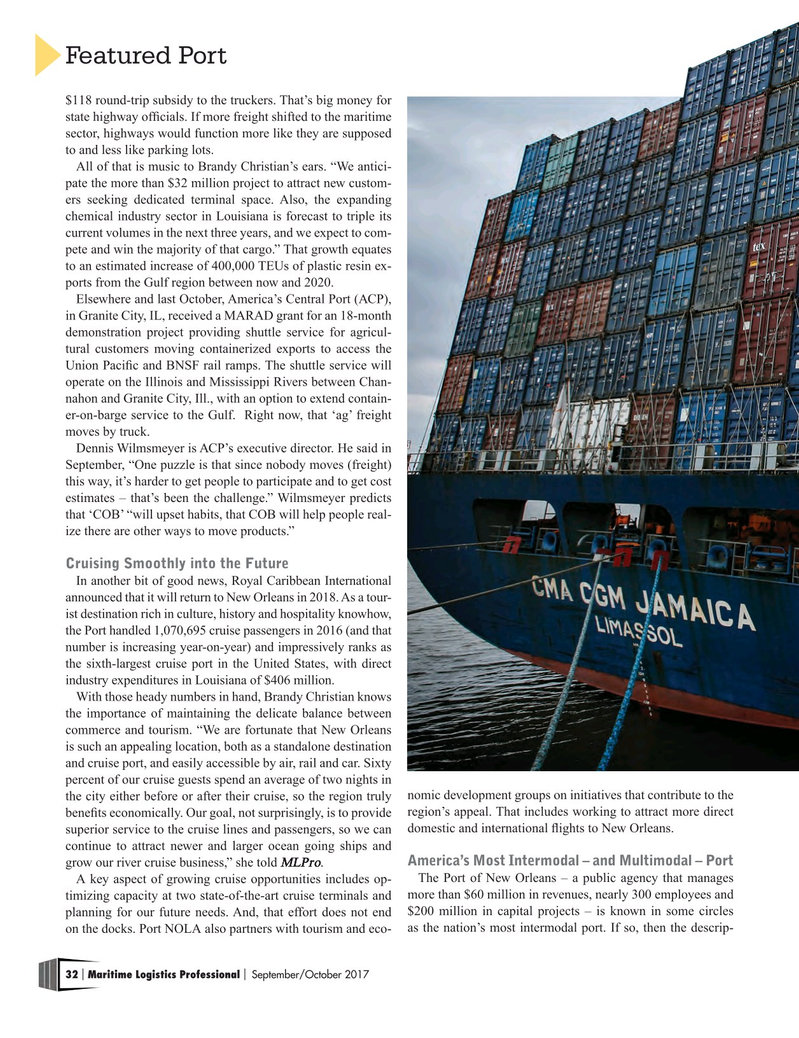
Page 32: of Maritime Logistics Professional Magazine (Sep/Oct 2017)
CONTAINER PORTS
Read this page in Pdf, Flash or Html5 edition of Sep/Oct 2017 Maritime Logistics Professional Magazine
Featured Port $118 round-trip subsidy to the truckers. That’s big money for state highway offcials. If more freight shifted to the maritime sector, highways would function more like they are supposed to and less like parking lots.
All of that is music to Brandy Christian’s ears. “We antici- pate the more than $32 million project to attract new custom- ers seeking dedicated terminal space. Also, the expanding chemical industry sector in Louisiana is forecast to triple its current volumes in the next three years, and we expect to com- pete and win the majority of that cargo.” That growth equates to an estimated increase of 400,000 TEUs of plastic resin ex- ports from the Gulf region between now and 2020.
Elsewhere and last October, America’s Central Port (ACP), in Granite City, IL, received a MARAD grant for an 18-month demonstration project providing shuttle service for agricul- tural customers moving containerized exports to access the
Union Pacifc and BNSF rail ramps. The shuttle service will operate on the Illinois and Mississippi Rivers between Chan- nahon and Granite City, Ill., with an option to extend contain- er-on-barge service to the Gulf. Right now, that ‘ag’ freight moves by truck.
Dennis Wilmsmeyer is ACP’s executive director. He said in
September, “One puzzle is that since nobody moves (freight) this way, it’s harder to get people to participate and to get cost estimates – that’s been the challenge.” Wilmsmeyer predicts that ‘COB’ “will upset habits, that COB will help people real- ize there are other ways to move products.”
Cruising Smoothly into the Future
In another bit of good news, Royal Caribbean International announced that it will return to New Orleans in 2018. As a tour- ist destination rich in culture, history and hospitality knowhow, the Port handled 1,070,695 cruise passengers in 2016 (and that number is increasing year-on-year) and impressively ranks as the sixth-largest cruise port in the United States, with direct industry expenditures in Louisiana of $406 million.
With those heady numbers in hand, Brandy Christian knows the importance of maintaining the delicate balance between commerce and tourism. “We are fortunate that New Orleans is such an appealing location, both as a standalone destination and cruise port, and easily accessible by air, rail and car. Sixty percent of our cruise guests spend an average of two nights in the city either before or after their cruise, so the region truly nomic development groups on initiatives that contribute to the benefts economically. Our goal, not surprisingly, is to provide region’s appeal. That includes working to attract more direct superior service to the cruise lines and passengers, so we can domestic and international fights to New Orleans. continue to attract newer and larger ocean going ships and
America’s Most Intermodal – and Multimodal – Port grow our river cruise business,” she told MLPro.
A key aspect of growing cruise opportunities includes op- The Port of New Orleans – a public agency that manages timizing capacity at two state-of-the-art cruise terminals and more than $60 million in revenues, nearly 300 employees and planning for our future needs. And, that effort does not end $200 million in capital projects – is known in some circles on the docks. Port NOLA also partners with tourism and eco- as the nation’s most intermodal port. If so, then the descrip- 32 Maritime Logistics Professional September/October 2017 | |

 31
31

 33
33
